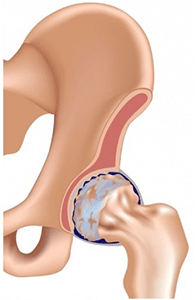What is Osteoarthritis?

Osteoarthritis (OA) is the most common form of arthritis in the world. And, it is commonly referred to as “wear and tear” arthritis, and degenerative joint disease. When the disease begins to affect one of your joints, a series of reactions take place. And this is actually the start of degeneration. Your once-healthy bone and the “soft tissue” around the joint – tendons and cartilage, is now slowly thinning.
Once the cartilage that cushions and protects the bones of the joint breaks down, the bones of your joint will eventually rub directly against each other. Your body reacts to this by creating bone spurs. And the joint capsule itself may thicken and weaken. Then, inflammation eventually sets in, leading to pain. When it occurs in the lower back, aches and a feeling of stiffness may result.
Doctors talk about two types of Osteoarthritis, primary and secondary,. Primary Osteoarthritis often refers to “everyday wear” while Secondary Osteoarthritis is considered the result of a maligned joint, being overweight, injury, or overuse. *1, *2
Who is affected by The Disease?
Twenty-one million people are affected by this disease in the United States alone. *3 Although this condition can affect anyone at any age, it has been linked to the aging process. In fact, more than 50% of all people over 65 show Osteoarthritis symptoms in one or both knees! And by the age of 75, virtually everyone suffers from Osteoarthritis in one or more joints.
However, Osteoarthritis of the knee and hips continues to be the most common cause of arthritis-related disability for Americans. The Arthritis Foundation cites that men and women may develop the condition at different times in life. Additionally, most people develop symptoms after 45, but, as a group, men under 55 and women over 55 develop the disease more frequently.
Osteoarthritis Symptoms & Causes
Some people who have the disease say they feel no pain. While most people who have it experience pain and feel joint stiffness (especially in the morning.) Additionally, they show signs of swelling and tenderness in one or more joints, and may even hear a crunching sound in the joints.
For some people, this disease can become completely debilitating. *3
- Stiffness or pain in the lower back
- Swelling and tenderness in joints
- Crunching sound in joints
Among the causes of Osteoarthritis, there have been identified the following two:
- Normal aging process
- Previous trauma or fracture
Also, see: 7 Signs of Knee Arthritis
Diagnosing the Disease
For a proper diagnosis, your doctor will consider your symptoms and your medical history, examine your joint(s) and order one or more diagnostic tests. Your physician may order blood work, X-rays, a CT scan, or an MRI. This will allow for a clear view of the alignment of your painful joint. And its condition.
Osteoarthritis treatment
Your doctor may recommend different treatment options depending on the severity of your osteoarthritis condition. However, its impact on your joint(s) and your daily life will also be taken into consideration.
Pain Management
Your doctor may prescribe or recommend the use of anti-inflammatory medications (like aspirin or ibuprofen) and cold packs that may help to reduce inflammation as well as the pain associated with osteoarthritis. Sometimes a local injection of cortisone can be performed to further reduce inflammation, thus reducing the pain.
Lifestyle changes
Your doctor may recommend that you lose weight. In fact, they might recommend specific nutritional supplements and exercise. In some cases, physical therapy may help provide pain relief and the return of some lost mobility, through guided techniques.
Bracing and Orthopedic Support Devices
Orthotic devices sometimes help. Custom-made shoes and shoe inserts provide support for those with Osteoarthritis in the foot or ankle. Your doctor may recommend a brace or a cane to help take some of the pressure off your affected joint while you walk if osteoarthritis is affecting your knee or hip.
Surgical Options
After conservative methods are tried and if you are still experiencing joint damage, your doctor may suggest surgery to help relieve your pain. And also to restore mobility. Your physician will determine the proper surgical treatment based on the severity of your arthritis and its location.
In fact, a full range of surgical solutions exists today. They enable your doctor to customize surgical procedures to your particular needs and anatomy, such as:
- Arthroscopic debridement: removing inflamed and/or irritating debris from the joint.
- Arthrodesis: fusing the joint for better support.
- Arthroplasty: replacing the arthritic joint.
Furthermore, Be sure to talk with your doctor about the best treatment option for you. In addition, if you need to speak with a specialist, please contact us at 1-888-409-8006
References:
1. Mayo Foundation for Medical Education and Research. Osteoarthritis: Introduction. Available at:https://www.mayoclinic.com/health/osteoarthritis/DS00019. Accessed February 4, 2008.
2. MedicineNet, Inc. Osteoarthritis. WebMD. Available at:http://www.medicinenet.com/osteoarthritis/page5.htm#minimal. Accessed February 4, 2008.
3. Arthritis Foundation. Osteoarthritis: Who Gets It? Available at: http://www.arthritis.org/disease-center.php?disease_id=32&df=whos_at_risk. Accessed November 5, 2008.
